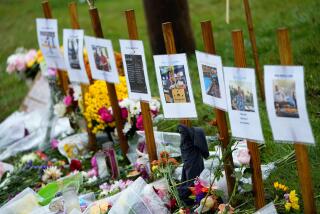Army School a Training Ground for Engineers
- Share via
FT. EUSTIS, Va. — Ted Palmer, 22, graduated from Marquette University last June as a history and philosophy major. He is taking a year off from studies and plans to go to law school next fall.
“In the meantime, I have been working as an accountant,” the young man from Milwaukee explained. “I was looking for a little excitement.”
Palmer found what he was looking for here at Ft. Eustis, the Army’s transportation school, 10 miles south of historic Williamsburg, Va.
Here, as an Army reservist, he is learning to become a railroad engineer.
“I had a Lionel train when I was a kid,” Palmer recalled, sitting in the cab of a big GP-9 diesel railroad locomotive, driving a train down the tracks on this Army base. He was all smiles. “Look at me now. I’m an engineer on the Real McCoy. I love it!”
Eighteen-year-old James Floyd Jr. of New London, Conn., graduated from high school last June, then went to work as a bellman in a hotel. He too joined the Reserves, and thanks to the Army is also learning how to be a railroad engineer.
Both young men are members of Army Railroad Reserve units. There are three rail battalions in the nation, at Milwaukee, Wis.; Middletown, Conn., and Tampa, Fla., with a total of 1,000 reservists.
Kept ‘Em Moving
From the Civil War through the War in Vietnam, the Military Railway Service was an important part of the Army. Soldiers served as engineers, conductors, brakemen, dispatchers, electricians and mechanics here and overseas, moving millions of troops and millions of tons of war equipment and supplies by rail.
The military continues to rely heavily on railroads for transportation of personnel and equipment, but all of the track and trains on military bases today are civilian operated.
In the early 1970s, the last of the rail units were disbanded from the regular Army and only the three rail battalion reserve units remain as a reminder of the major role played by Army railroaders for more than a century.
This year saw the return here at Ft. Eustis of rail training at an Army base for the first time since 1959. Fort Eustis is the Army’s national transportation center, where 8,800 officers and enlisted men each year attend and graduate from the Army Transportation School.
But only a handful of reservists, for now at least, are once again learning the ropes of railroading on the 30 miles of Ft. Eustis railroad-training track left over from World War II.
A dozen to 15 reservists at a time take leave from their regular civilian jobs to come here for the newly inaugurated five-week railroad-training classes. The rest of the year the reservists train one weekend a month with their battalions in Tampa, Middletown or Milwaukee.
Some of the monthly weekend sessions include railroad-yard classes.
Instructors here at Ft. Eustis are veteran railroaders like Frank Himmelwright, 60, a railroad engineer 30 years; Jim Scheumack, 68, a roundhouse maintenance man for railroads 35 years and Robert Young, 62, a train dispatcher 40 years.
“We get to try our hand at working as brakemen, conductors, in maintenance, and repairing track. And, everybody in the class gets to drive a train,” explained Bruce Dyson, 33, a reservist from Milwaukee. “We learn basic skills of railroading, the signals, handling hazardous cargo, the whole works.
“I’ve driven just about every kind of a truck. But running a train is something special. You really feel the power when your hand is on the throttle. Safety is of utmost importance.”
Dyson has been in the National Guard eight years and the Army Reserves four years. In civilian life he is a security officer.
Connecticut Game Warden
Larry Samperi, 40, of West Haven, Conn., is a Connecticut game warden. He worked for New York, New Haven & Hartford Railroad eight years as a rail-car inspector. He has been an Army Reservist five years with the rail battalion in Middletown.
“Many in our battalion work for the railroad now or worked for a railroad at one time,” Samperi noted. “And others in our outfit come from a variety of work places. Our commanding officer is president of an insurance company, another fellow is a banker. Some play with small trains as a hobby.”
Mamie Simmons, 32, of Milwaukee, is one of few women serving in rail battalion reserve units. In civilian life she is a dental hygienist. Her husband is a police officer. They have two children.
“I have been six months in the rail battalion. I wanted to do something different than I do on my regular job. This is different! My friends are astounded when I tell them what I’m doing as a reservist in the Army.”
The reservist railroad class at Fort Eustis has two diesel-powered engines, acquired last March from the Southern Pacific Railroad. The two GP-9 SP locomotives built in the early 1960s operated out of Southern California before coming to Virginia.
Rolling stock owned by the railroad school at Ft. Eustis include tank, box and flatcars with four passenger cars doubling as classrooms.
More to Read
Sign up for Essential California
The most important California stories and recommendations in your inbox every morning.
You may occasionally receive promotional content from the Los Angeles Times.










